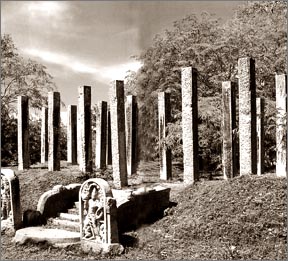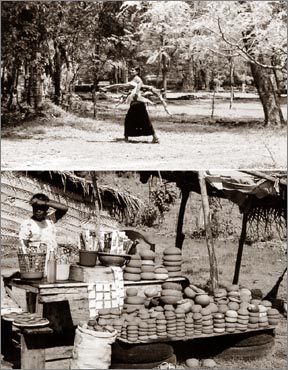|
observer |
|
|
|
|
|
OTHER LINKS |

|

|

|
The sound of life amidst ruins
Excavations carried out in the 20th century verify that human settlements in Anuradhapura began around 500 BC. The Mahavamsa gives an inkling to the origins of the name of the city. Three 'Anuradhas' (born or ruling under the constellation Anuradha) were involved in the founding and development of the city, hence the city came to be known as the 'city of Anuradha' or Anuradhapura. Anuradhapura is now a standard location on a tourist's visit to Sri Lanka, and even locals consider it to be the domain of the foreign tourist or the devout Buddhist. While both are found in plenty within Anuradhapura, this is also a city that lives and breathes the rhythm of life. And there is plenty to explore and discover within this ancient city. A day visit to Anuradhapura can be filled to overflowing with places to see and facts to absorb, so why not spread it over a weekend and explore this town at leisure? It's a great place to base yourself, to explore the delights of Minneriya, Wilpattu, Mihintale, Sigiriya and Dambulla. You can even include a leisurely exploration of Polonnaruwa and return to Anuradhapura the same day. But first, there is Anuradhapura itself to discover. Anuradhapura is a city which combines the heritage of the past with a very modern present, and this co-existence is a wonderful discovery in itself. Villages have sprouted within calling distance of the ruins, and we watched a woman pick firewood in the forest, walking past the great Elephant Pond without a glance at its intricate rock carvings. Village children play in the large shaded parklands which surround the Abhayagiri Temple, and it is wonderful to hear their laughter - the sound of life amidst the ruins. Many villagers, especially women, work with the Department of Archaeology and the restoration teams. Others are involved in chena cultivation in small pockets of land, or they make up the horde of salesmen who abound at every site of interest in the city. They sell everything from fruit to charms to Buddhist prayer books, and if you are a keen 'bargainer', you will meet your match in these hardy sales people. I tried my luck, and failed miserably, buying a hair ornament which I was sure I would get for half the price at the village market. This large pola (village market) in Anuradhapura town is held every Saturday and is a sight to behold with the cries of sellers, and a bustling rhythm twice that of any village market. Village produce, fresh from the chena are found in plenty. Pumpkins, watermelon, cucumber, chillies and various types of grain fill the long, makeshift market structures. The more permanent structures behind these hold fabric of any colour and design you can imagine, household utensils, stationery, and many shops selling 'fancy goods'. Though a warm, dry heat pervades all parts of Anuradhapura, a walk around the town in the early morning or early evening hours will give you a better understanding of this town. Friendly people with welcoming smiles, they seem to have all the time in the world for you. Feel free to chat to the man selling manioc chips by the roadside or the burly man at a small stationery store which had the best postcards in town. They will tell you more about Anuradhapura than all the guidebooks, and certainly it will be far more interesting and entertaining. As you enjoy the ruined city, the sacred temples and places of worship, keep your eyes open to the real heart of Anuradhapura - its people. Many centuries before the birth of Christ, while other regions were emerging from the late Stone Ages, Sri Lanka was a land with a highly advanced civilization with well-ordered cities linked by a fine road network, and a land nourished by an awe-inspiring irrigation system. In its time, Anuradhapura was the greatest city of all. The ruins display details of rare beauty and skill, and its stonework and masonry are rated by international archaeologists as second only to the great Pyramids of Egypt. Excavations carried out in the 20th century, verify that human settlements in Anuradhapura began around 500 BC. The Mahavamsa, the chronicle of Sri Lanka's ancient history, gives an inkling to the origins of the name of the city. Three "Anuradhas" (born or ruling under the constellation Anuradha) were involved in the founding and development of the city, hence the city came to be known as the "city of Anuradha" or Anuradhapura. A general and a nephew of Prince Vijaya, and King Pandukhabhaya are thought to be the three Anuradhas. Anuradhapura remained the capital of Sri Lanka for about 1,400 years until the 10th Century AD. It covered over 50 square kilometres and had a population estimated at several tens of thousands. Houses two or three storeys high and perhaps two storeys underground were common. Minor streets were organised according to classes of artisans and industry thrived. The king lived in a bejewelled palace, records the Mahavamsa, with 1,000 chambers. After the 13th Century AD, Anuradhapura ceases to be mentioned in the chronicles and ancient records, and Polonnaruwa asserts itself as the capital of Lanka. Although the kings of Polonnaruwa attempted to restore some of its buildings, the irrigation systems fell to ruins and the city was taken over by the jungle. That is, until its discovery in the 1820s by a young British civil servant, Ralph Backhaus who mounted a private expedition to rediscover this ancient capital. There are many places to see, and ruins to be amazed at. We highlight a few of the marvels that are found in Anuradhapura, as well as more regular features which are certain to make your stay more interesting. Visit some of these sites at dusk or at night - such as the Mirisavetiya or Sri Maha Bodhi and you will be dazzled by the lights and the beauty of this city of ruins. To Buddhist pilgrims, no spot is more sacred than the Sri Maha Bodhi. Unlike the other buildings and places of worship in Anuradhapura, this Bo Tree was cared for and protected generation after generation by hereditary guardians - a practice which continues today. This is also the oldest historically documented tree on earth, and is believed to be a sapling from the Bo Tree beneath which Gautama Buddha attained enlightenment. Today iron crutches support the boughs of the tree, and it stands on a special platform encircled by a gold-plated railing. Many of the Bo Trees found in Sri Lanka, and even in Thailand and Burma, are seedlings from the Sri Maha Bodhi. The Ruwanveliseya, a mahasthupa raised in the 2nd Century BC by King Dutugemunu is regarded as the greatest of Anuradhapura's dagobas. It was completed while the King lay on his deathbed in 144 BC. Famous for its original "water bubble" shape, reconstruction work in the late 19th and early 20th centuries have failed to regain this original shape. There are four gatehouses at each of the four cardinal points which mark the dagoba's outer walls. An impressive elephant wall holds up the dagoba platform - this is symbolic of the way in which elephants hold up the earth in Buddhist cosmology. There are four 8th century limestone statues of the Buddha, beside a modern sculpture of Maitreya, the future Buddha. A larger-than-life statue of a man - considered by many to be that of Dutugemunu himself stands respectfully facing the dagoba. Courtesy Explore Sri Lanka |













